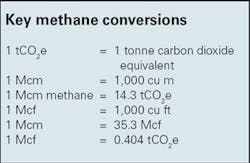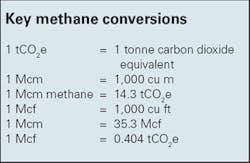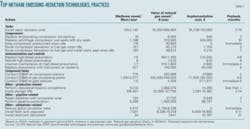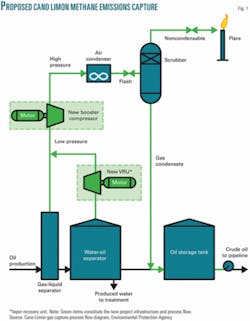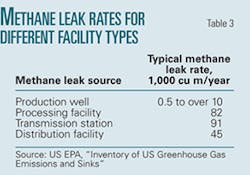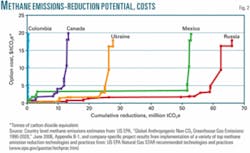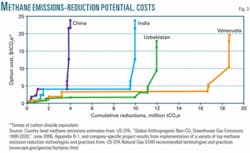Technology drives methane emissions down, profits up
The extent of methane emissions worldwide is significant and indisputable. The economic benefits from containing such emissions are equally compelling. These include higher revenue from additional gas sales and labor savings, carbon credits, and greater process efficiency.
This article summarizes a number of proven methods to identify, measure, and reduce methane emissions from a wide range of equipment in production and processing facilities as well as through transmission and distribution facilities in the gas supply chain.
In addition, the article provides examples of measures companies are taking and technologies they are using to deliver greater revenue as well as environmental benefits to shareholders worldwide.
The case studies presented here and the complete range of projects being implemented by industry demonstrate several facts:
- Identification and quantification of existing methane emissions constitute a key first step to project implementation.
- Proven recovery technologies provide compelling economic and environmental benefits.
- Company leadership at the highest levels accelerates implementation by aligning resources and capital to utilize emissions reductions.
Containment of methane emissions from the global oil and gas infrastructure represents an opportunity to improve the environment and generate substantial economic and energy benefits.
Methane emissions mitigation is of interest not only to operators but also to service providers, investment banks, corporate shareholders, and the public. Methane mitigation work has increased as a result of a collaborative effort by this diverse set of stakeholders.
Global emissions
While methane is a source of clean energy, it also is a very potent greenhouse gas. Lost into the atmosphere each year from oil and gas operations worldwide is nearly 82 billion cu m of methane, which equates to a loss of about $20 billion in revenue.1 Moreover, these emissions have an equivalent annual greenhouse gas effect comparable to adding more than 200 million vehicles to the roadways.
Methane emissions resulting from oil and gas production, processing, transmission, and distribution operations can take the form of unintentional leaks as well as venting from operational processes. Such practices include venting from well cleanups or workovers, reciprocating and centrifugal compressor operation, crude oil and condensate storage tanks, and pipeline repairs. Table 1 indicates methane emission trends in several key countries with established or growing oil and gas infrastructures.
The US Environmental Protection Agency projects that global methane emissions will grow by more than 33% during 2005-15. These emissions represent a compelling opportunity to generate considerable additional revenue with the technologies discussed in the balance of this article.
Mitigation options
Profitable methane emission reduction projects exist throughout the entire gas infrastructure, from wellhead to burner tip. Methane emission reduction strategies generally fall into one of three categories:
- Employing new technologies or upgrading equipment to reduce venting or fugitive emissions.
- Improving operational procedures.
- Enhancing management practices.
The information presented here updates and expands on analyses previously published in OGJ on cost-effective technologies to cut methane emissions globally.2
Various project options such as upgrading compressors, replacing pneumatic devices, and conducting leak surveys have broad applicability globally and across the industry.
Based on EPA emissions estimates and Energy Information Administration production estimates,3 more than 2.8% of net worldwide dry gas production is emitted to the atmosphere. Each emissions source represents unrealized revenue. Table 2 provides information on proven, cost-effective technologies and practices that have broad applicability in addressing major sources of methane emissions from oil and gas operations. Investment costs for these technologies and processes range from $0 to $324,000, with payback periods ranging from immediate to 21 months. Operators can recover their investments through a number of economic channels, including gas sales revenue, carbon credit revenue, on-site fuel use, reduced labor costs, reduced capital replacement costs, lower environmental permitting costs, and reduced environmental impact. Project examples were selected from representative successful field implementations for specific emissions sources. In each case, operators identify emissions sources, quantify the product loss, and apply off-the-shelf, mature solutions to recover methane.
Tanks
Crude oil and gas condensate production field tanks hold petroleum liquids briefly to stabilize flow or for trucking or pipeline transportation to processing and refinery sites. During storage, light hydrocarbons dissolved in the crude oil-including methane-vaporize or “flash” and vent to the atmosphere from fixed-roof field production tanks. When uncontrolled, these tanks vent 0.2-1.2 cu m/year of methane/bbl of crude oil and condensate.
One way to capture tank emissions is to install vapor recovery units (VRUs) on oil and condensate storage tanks. VRUs are relatively simple compression systems that can recover about 95% of tank vapors for sale or for use on site as fuel. Since tank vapors also include hydrocarbons heavier than methane, on a volumetric basis, the recovered vapors can be more valuable than methane alone. A VRU project under way by Occidental de Colombia (Oxy) illustrates how methane and nonmethane tank vapors can represent economic opportunity.
Oxy’s Cano Limon facilities in Colombia produce 35 million bbl/year of crude oil that flows through production site tanks, emitting about 166,000 cu m/year of methane. Oxy identified this product loss and is now modifying its facilities to include VRU and booster compressors to boost vapors to a high pressure (Fig. 1).
Following compression, existing air coolers lower the stream temperature to ambient temperature. The compressed vapor then expands through a valve into a scrubber, which reduces the stream to subambient temperature and condenses the heavier components. Condensed liquids are blended with the crude oil, and noncondensable vapor, including methane, is flared.
The feasibility study estimates vapor recovery and booster compressor investments of about $1.57 million for equipment costs. Operating and maintenance costs are estimated at $805,000/year. For its investment, Oxy will benefit from an estimated incremental 360,000 bbl/year of condensate blended into the crude, worth about $18 million/year at a nominal $50/bbl. The project also eliminates methane venting from tanks.
Compressors
Compressors are a logical focus area for methane emissions due to the variety of emissions encountered with operation of these units. Both reciprocating and centrifugal compressors potentially vent methane when taken out of service. Both compressor types also lose methane through the seal between the driver shaft and compression case.
Many centrifugal compressors are configured with oil seals, called “wet seals,” at the point where the rotating driver shaft exits the high pressure case. Wet seal systems circulate oil across the seals to create a barrier between compressed gas and the atmosphere. Although these are very good seals, the seal oil absorbs methane and must be degassed to maintain viscosity and lubricity. The methane-rich gas is normally vented to the atmosphere at remote field locations. A single wet seal centrifugal compressor can vent as much as 1.8 million cu m/year of methane.
Wet seals can be replaced with “dry” seals, which provide the same barrier to high pressure gas leakage with lower operating and maintenance costs and lower methane emissions. Each dry seal upgrade reduces methane emissions by 1.2-1.7 million cu m/year, or 67-98 %.
Petroleos Mexicanos (Pemex), Mexico’s nationally owned petroleum company, has upgraded three wet seal centrifugal compressors with dry seals as part of a larger methane emissions reduction strategy. Dry seal first year investment costs are typically $317,000/compressor or $12.40/tonne of carbon dioxide equivalent (tCO2e) methane saved. Benefits of the investment include increased throughput, reduced methane emissions, and avoided seal oil system operating and maintenance costs, which pay back the investment in about 10 months. On average, operators report saving about $316,000/year in reduced methane emissions and $88,000/year in avoided operating costs on each compressor.
Instrumentation, controls
Gas-powered pneumatic valve control devices are one of the largest sources of methane emissions from oil and natural gas operations. The emissions come from a continuous “bleed” or gas vent stream that transfers a process measurement to a control valve actuator. Many pneumatic devices worldwide are considered “high-bleed” devices and typically vent more than 1,500 cu m/year of methane for each control loop, which consists of the valve actuator and the process measurement control such as a level, pressure, or temperature control. While facilities that are able to do so could implement pressurized air, electric controls, or mechanical controls-the only power source available at remote, nonelectrified sites-may be pressurized gas.
Operators are replacing older model, high-bleed controllers with “low-bleed” gas pneumatic devices, which can perform the same function but reduce bleed rates by 1,000-5,000 cu m/year. As low-bleed pneumatic devices have become the industry standard, their capital costs are often lower than high-bleed pneumatic devices. Methane savings from low-bleed devices pay back the device replacement within 3-8 months.
Marathon Oil Co. is one operator that reduced product loss from pneumatic devices. The company used the Bacharach Inc. Hi Flow Sampler to survey controllers at 50 production sites. It found that high-bleed devices accounted for 35 of its 67 level controllers, 5 of the 76 pressure controllers, and 1 of its 15 temperature controllers. Measured gas emissions amounted to 145,000 cu m/year. Marathon concluded that high bleed rates can often be identified qualitatively by sound, facilitating identification of the product loss.4
Component leaks
All valves, flanges, connections, open-ended lines, and other components in the gas infrastructure are potential sources of methane emissions (Table 3). Unintended component leaks develop over time in response to temperature fluctuations, pressure, corrosion, mechanical vibration, defective installation, and wear. These leaks are usually invisible and odorless and therefore go unnoticed. The very large number of components with individually small leaks compound into significant methane losses.
One proven solution for addressing these leaks is implementing a directed inspection and maintenance (DI&M) program. DI&M is a proven, cost-effective way to detect, measure, prioritize, and repair equipment leaks to reduce methane emissions. A DI&M program begins with a baseline survey to identify and quantify leaks. Subsequent surveys are based on data from previous surveys, allowing operators to concentrate on the components that are most likely to leak and are profitable to repair. Several leak screening techniques are commercially available, ranging from a soap solution to infrared leak imaging cameras (Table 4). Baseline survey results typically show that the large majority of fugitive methane emissions are from a relatively small number of leaking components that can be targeted for monitoring. A simple investment in labor yields benefits of increased production or throughput, reduced emissions, and potential carbon credits.
With these DI&M concepts in mind, Cherkassytransgas (CT) in Ukraine hired Indaco Air Quality Services to survey two of its compressor stations. Indaco’s survey used catalytic oxidation and thermal conductivity detectors combined with soap solution to identify 280 leaks. Each emission was quantified with the Hi Flow Sampler, and the total methane emissions rate was over 2.8 million cu m/year. Recognizing these results as a product loss and potential market commodity, CT prioritized repair work, ultimately repairing 227 of the 280 emissions sources to save 1.9 million cu m/year. Nonrepaired emissions include leakage from compressor unit valves and blowdown valves. Methane savings were confirmed with post repair measurements. Survey, measurement, repair, and training required an investment of $7/tCO2e/year saved. In addition, CT expects to gain additional revenue through exchanging carbon credits with a Canadian buyer for another $160,000/year over the course of 10 years.5
The Kursk Natural Gas Distribution Co. (Kurskgas) in Russia also identified methane leaks as an opportunity. Kurskgas retained Heath Consultants to survey 47 regulator stations in November 2005. Using catalytic oxidation and thermal conductivity detectors, Heath surveyed 1,007 components and discovered 94 leaks-90 from valve stem packing, 3 from pressure relief valves, and 1 from a flange. Using the Hi Flow Sampler, Heath quantified all leaks and reported a total methane emissions rate of over 900,000 cu m/year.
Following the survey, Kurskgas and Heath began a pilot effort to replace leaking stem packing in seven valves. Worn packing on each valve was replaced with W.L. Gore & Associates Inc. valve stem packing for a total material cost of $7. Leak reduction was immediate, and validation measurements confirmed that each leak was reduced to a level below detection.
The initial Kurskgas investment was $30,000, or $2.40/tCO2e/year, assuming that all leaks were repaired. Positive initial results prompted Kurskgas to expand the initial 47-station study into a survey, measurement, and repair campaign across more stations, covering over 3,300 components.
The project was the first leak survey in Russia meeting eligibility requirements for joint implementation under the Kyoto Protocol, meaning that it produces revenue in the form of verified carbon credits.
Global project potential
Even with the industry’s application of these methane emission reduction technologies and practices, there are still profitable opportunities for the oil and gas industry throughout the world. Fig. 2 represents methane emissions-reduction project potential in the five countries discussed in the case studies. Each country is represented by a marginal abatement cost curve showing cumulative emissions reduction potential on the x-axis and the reduction cost on the y-axis. The curves are based on methane emissions shown in Table 1, mitigation project options such as those identified by Table 2, and a discounted cash flow analysis using a 10% discount rate.
The reduction cost is also a project’s breakeven value. Because methane is valued differently depending on its use and the local market, the breakeven value can be reached in a variety of ways such as end-use sales revenues, operating cost savings, or carbon credit sales. The curves for each of the five countries show that a significant fraction of emissions reductions are achievable at values under $5/tCO2e.
The country curves provide a high level view of methane emissions reduction potential and the cost tiers of proven mitigation options. As expected, countries such as Russia with more-extensive oil and gas infrastructure have more potential reductions than countries such as Colombia having less infrastructure. All countries have oil and gas infrastructure to some degree, and countries with growing energy demand, production, and transmission are expected to increase methane emissions significantly through 2015, based on the EPA outlook. Fig. 3 shows similar curves for several key nations rapidly developing a more-extensive oil and gas infrastructure, such as China, India, Uzbekistan, and Venezuela. For these countries-as with any country-developing new infrastructure using best practices in methane emissions management is essential to environmental stewardship as well as project economics.
While the country curves indicate that potential exists in many regions, achieving results requires companies to identify the emissions and invest in the proven technology. TransCanada Pipelines has achieved over 2 million tCO2e/year savings over the last 10 years through projects such as leak surveys, low-emission compressor seals installation, and blowdown avoidance. A three-tier approach effectively translated emissions management into emission reductions. First, senior leadership provided strategic direction and approved projects to align with business needs. Second, program management measured progress on existing work and oversaw research on new mitigation options. Third, the execution and monitoring of these projects logged performance data that allowed for continuous improvement.
Pemex currently is well under way with a similar initiative to identify, measure, and capture methane emissions across its entire oil and gas infrastructure. The technologies and strategies Pemex and TransCanada are using and case studies of many other global oil and gas operators are available to any company or investor online through EPA’s Natural Gas STAR web site.6
Global partnership
One successful initiative for decreasing emissions to increase revenue is Methane to Markets-a partnership comprising 20 nations focused on the goal of implementing the project types shown here. The role of the Methane to Markets Partnership is to bring organizations together with international governments to stimulate development of methane mitigation projects. Under this framework, US EPA launched Natural Gas STAR International, a partnership with oil and gas companies. About 120 oil and gas operators around the world participate in Natural Gas STAR, voluntarily advancing the recovery and use of methane as a valuable clean energy source.
The private sector, the research community, development banks, and other organizations also collaborate to execute such methane-saving projects (www.methanetomarkets.org).
An upcoming Methane to Markets Project Expo in October in Beijing, China, will bring together oil and gas operators and other stakeholders to combine resources and knowledge for profitably harnessing methane emissions.
Further information on the technologies discussed in this article can be found at EPA’s methane emissions-containment web site (www.epa.gov/gasstar/techprac.htm).
References
- Natural gas valued at 25¢/cu m ($7/Mcf).
- Fernandez, Roger, Lieberman, Daniel, and Robinson, Don, “US Natural Gas STAR program success points to global opportunities to cut methane emissions cost-effectively” (OGJ, July 12, 2004, p. 18). See also OGJ, Sept. 2, 2002, p. 22.
- US EPA worldwide methane emissions estimate (“Global Anthropogenic Non-CO2 Greenhouse Gas Emissions: 1990-2020,” June, 2006, Appendix B-1) divided by EIA worldwide dry gas production estimate (www.eia.doe.gov/emeu/international/gasproduction.html).
- US EPA, “Options for reducing methane emissions from pneumatic devices in the natural gas industry” (www.epa.gov/gasstar/pdf/lessons/ll_pneumatics.pdf).
- Reducing Methane Gas Leaks at Cherkassytransgas (www.rec.org/ecolinks/bestpractices/PDF/ukraine_cherkassy.pdf).
- US EPA Natural Gas STAR recommended technologies and practices (www.epa.gov/gasstar/techprac.htm).
The authors
Brian Gillis, an associate at ICF International, has developed greenhouse gas emissions inventories for public and private sector clients ranging from site evaluations to country-wide estimates. His inventory work includes first-principles engineering studies to quantify greenhouse gas emissions. He is a developer of ICF’s proprietary greenhouse gas emissions management system, which inventories greenhouse gas emissions and evaluates the economics of control options. Gillis also has contributed to laboratory and field-based performance analyses of infrared remote sensing technologies to identify emissions from oil and gas equipment. For Natural Gas STAR, Gillis provides support on identifying and mitigating methane emissions from specific industry processes.
Suzie Waltzer (waltzer.suzanne @epa.gov) is a member of the US EPA’s climate change division and is a program manager for EPA’s Natural Gas STAR Program. She promotes the implementation of cost-effective operational efficiency improvements and technologies to reduce methane emissions from oil and gas operations. Previously Waltzer worked with EPA’s clean air markets division managing air quality and ecological assessments to evaluate the effectiveness of regional and national market-based emission control programs. Waltzer earned her master’s degree in environmental management from Duke University.
Milton W. Heath III manages the methane emissions measurement programs at Heath Consultants Inc. These programs have been used to determine cost-effective maintenance strategies for leak reduction and to recover gas lost through leakage. As part of these efforts, Heath has developed and manages training programs for industry personnel, making it possible for gas companies to acquire the necessary technology and skills to screen and measure methane emissions at their facilities. Heath earned a BS from the School of Natural Resources and Environment at the University of Michigan.
Jim Cormack works for TransCanada as an advisor on climate change and air emissions issues. He helps develop TransCanada’s climate-change policy, develops risk mitigation strategies related to air emissions for the company, and assesses financial risk to its assets arising from climate-change policy. Since 1996 Cormack has worked within the pipeline system design and operations groups. In 2004 he became an advisor on climate change and air quality issues. Prior to joining TransCanada, Cormack worked in plant process operations at various facilities, including oil refineries and gas processing plants. He chairs the Canadian Energy Partnership for Environmental Innovation and is a member of the Canadian Energy Pipeline Association’s climate change task group, the Canadian Gas Association’s air management subcommittee, and the Interstate Natural Gas Association of America’s committee for environment, health, and safety as well as the greenhouse gas task force.
Krish Ravishankar is worldwide director of environmental affairs for Occidental Oil & Gas Corp. in Houston. He has over 20 years’ experience and has worked with upstream and downstream energy industries and the power sector, consulting organizations, and international agencies such as the World Bank, East-West Center, Asian Development Bank, and International Finance Corp. He has published two books and numerous articles in international journals. He holds a bachelor’s degree in engineering and three masters’ degrees in development economics, resource economics, and environmental science.
